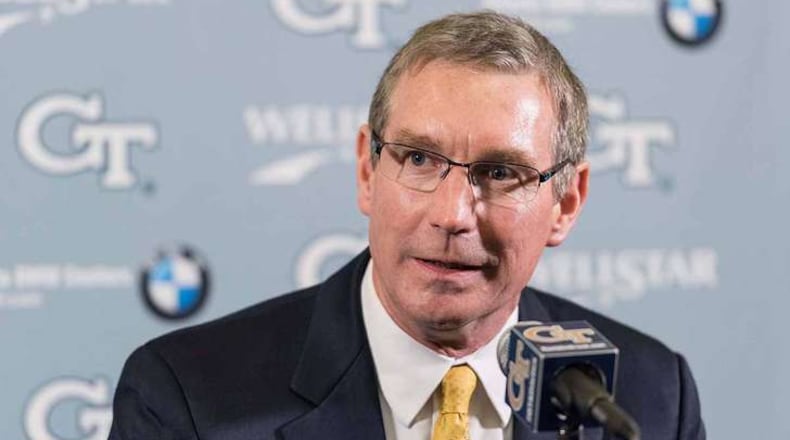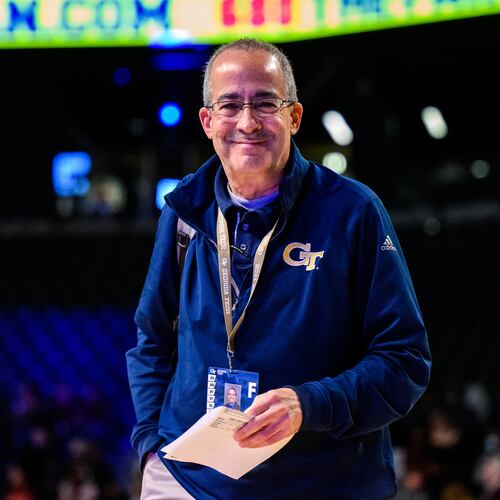Georgia Tech athletic director Todd Stansbury doesn't take lightly the health risks that Yellow Jacket athletes and staff will accept when voluntary on-campus workouts begin, scheduled for June 15. He sees it also as a chance to demonstrate leadership.
“I actually look at it – and I talked to our student-athletes about it – that we have a great, not only opportunity, but a responsibility in showing how students can come back to campus,” Stansbury said on a video conference with media Friday. “I see our phases as also a road map on how the rest of campus can eventually get back to full strength as well.”
Stansbury spoke in greater detail about policies for Tech athletes when training will be permitted to resume, first unveiled Thursday evening. They will be the first varsity workouts to take place at Tech since the coronavirus pandemic closed the campus in mid-March.
Among details that he shared Friday that were not in Thursday’s news release:
All athletes will be tested for COVID-19 upon their arrival, though the first phase of the return will be restricted to those in the Atlanta area, as on-campus housing has yet to open. There will also be surveillance testing once training begins, as well as testing for athletes or staff who demonstrate symptoms. A contact-tracing plan will be put in place, also.
“So there will be certain flags that would require additional testing,” Stansbury said.
Stansbury said that plans for the response to a positive test are evolving. That was part of the reason why the June 15 date was chosen, he said, “to be able to use the next two weeks to make sure we’ve got that nailed down.”
Incoming freshmen will not be permitted to participate in the first phase.
Where the first phase will include only Atlanta-area athletes and grant them access to the weight rooms and training rooms – practice fields and gyms will be closed – the plan for the second and third phases will be to welcome back more athletes and expand training.
Phase II “would be more focused on getting those fall (sports) student-athletes back as would be normal under normal circumstances to start with whatever team activities would be approved at the time,” Stansbury said.
The third and final phase would be beginning actual preseason training beyond strength and conditioning workouts.
“Make sure that you’re in a position to have a safe preseason, but also ultimately get your team ready to play,” Stansbury said.
He stressed the priority on a safe environment, demonstrated in training groups being limited to 10 athletes or fewer, with the makeup of the groups staying consistent throughout the first phase. During workouts, athletes and staff will be encouraged to wear masks. They will be required when social-distancing measures can’t be observed, such as when an athlete is being treated by a trainer, according to an athletic department spokesman.
Stansbury said that in his best-case scenario, “we’re going to be able to open up (fall sports schedules, including the football season opener Sept. 3 against Clemson at Bobby Dodd Stadium) as scheduled, and so our priority is making sure that our student-athletes are prepared to be able to do that.”
Stansbury said he did not know how many athletes will return June 15. Of the roughly 100 returning players on the football roster, the hometowns of about half are within a long commute from Tech’s campus. However, others whose hometowns are farther away who have been staying at their apartments near campus could also join. Undoubtedly, players who have been sheltering away from Atlanta will be tempted to return and stay with a teammate, friend or relative.
However, keeping initial numbers smaller may prove a wiser course, as facility space is limited and to not overwhelm staff who can only work with small groups. Coaches may focus on athletes who haven’t had access to weight-training equipment.
Tyke Johnson, father of graduate offensive lineman Ryan Johnson, told the AJC that his son likely won’t return to campus for the first phase from their home in Brentwood, Tenn., as he has a weight set and a field where he can work out.
Based on conversations that Stansbury said that he has had with Tech athletes – he recently led a “town hall” meeting with them – they are excited to return to campus and resume some form of their pre-pandemic lives.
“I haven’t heard anybody, really, that is concerned about coming back,” he said. “It’s really the opposite. They can’t wait to come back and they can’t get back fast enough.”
However, he described himself and the staff as “hyper-aware” that not all athletes might be as eager, and said coaches and administrators will be sensitive to those concerns.
“We in no way would want any of our student-athletes that didn’t feel safe coming back to come back,” he said.
Multiple parents of football players expressed their comfort with sending their sons back to campus for workouts.
“I’m very comfortable with them limiting it to the small groups,” said Roxanne Owens, mother of redshirt freshman wide receiver Zach Owens. “It doesn’t sound like there’s going to be a lot of exposure to a lot of people yet, so I think it’s a good plan.”
“I’m comfortable with them going back mid-June,” said Stephanie Knight, mother of sophomore linebacker Demetrius Knight. “It’s just the guys are going to have to be really conscientious of what they’re doing, and it’s not just so much for themselves as for their teammates.”
Tyke Johnson said he put his trust in coach Geoff Collins and his staff.
“I think they care about the program, but I think they put the boys in front of everything else,” he said. “That’s a comfort as a parent. We are all living in unsure times, but I don’t think we can hide.”
About the Author
Keep Reading
The Latest
Featured


